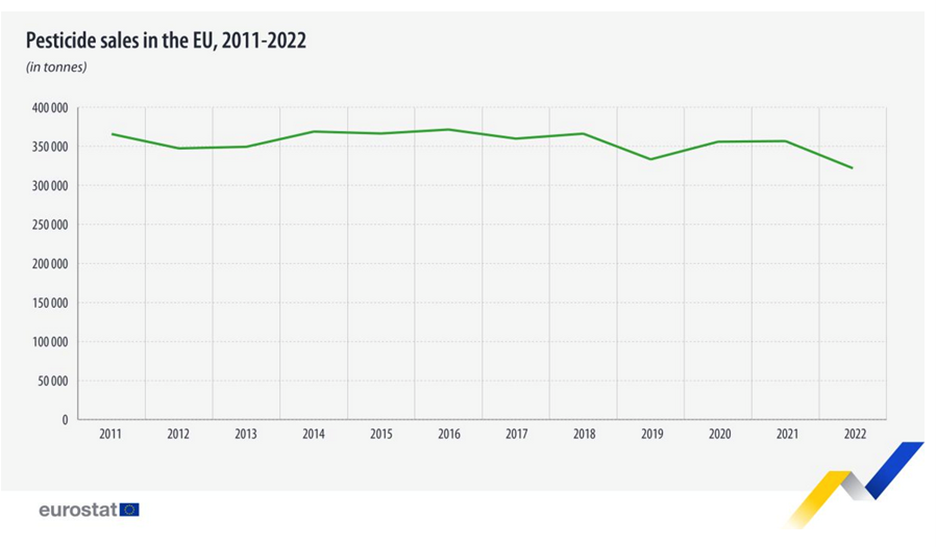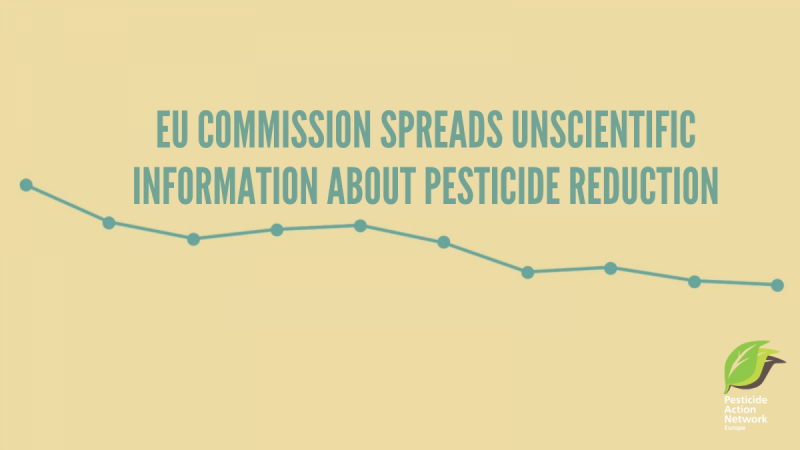According to a recent EU communication, the use and risk of chemical pesticides decreased by 46% compared to 2015-2017. Miraculous, for it contradicts Eurostat's pesticide sales data which show no clear decrease in pesticide use. It does not match the fact that sales of PFAS pesticides have tripled for example in France in the last 13 years. It does not match the 66% increase in the use of the most environmentally toxic pesticides in The Netherlands. It does not match the increase in sales of dangerous pesticides in Belgium. So what is wrong with the indicator used by the European Commission?
The Directorate General for Health and Food Safety from the European Commission reported on the 8th of July 2024 on the progress towards the Farm to Fork pesticide reduction targets for 2011-2022 (1).
The Commission uses two indicators to track progress towards the two pesticide Farm to Fork objectives:
- F2F1 objective: 50% reduction in use and risk of chemical (synthetic) pesticides by 2030: To measure progress towards this objective, the methodology of the HRI1 one, developed under the Sustainable Use of Pesticides Directive 2009/128/EC (SUD) is used. However, 2015-2017 is used as a baseline for the F2F1 objective, instead of 2011-2013. On the contrary to the SUD HRI1, only chemical pesticides are included, to track progress towards F2F1, while natural substances/biocontrol are not considered.
- F2F2 objective: 50% reduction in the use of more hazardous pesticides by 2030: To measure progress towards this objective, the sales of active substances approved as the so-called ‘candidates for substitution’ are used. These present about 50 very toxic pesticides, which member states are supposed to ban as soon as possible.
Selling imaginative pesticide reduction where there is none?
The HRI1 methodology has been applauded by the chemical industry but was criticised by PAN Europe, Global 2000, Générations Futures and many other organisations. National authorities like the German Environment Agency (UBA) agree. (2) They stress that the indicator is not scientifically justified, and it calculates decreases in pesticide use when none actually exist. The EU’s Court of Auditors (ECA) (3) underlined that the Commission should improve the HRI indicators or develop new indicators to achieve its objectives.
A main flaw of the indicator is that the volume of the used pesticide contributes strongly to the indicator. The result is that highly toxic insecticides and fungicides, that are used in smaller but very toxic amounts, are extremely underrepresented in the calculation. They are typically applied in much lower doses than lower-risk pesticides. To treat 1 hectare of scab, apple fungi, in an apple orchard an organic farmer would use 7,5 kilograms of environmentally harmless baking powder. A conventional farmer would use only 56 grams of an environmentally very harmful fungicide. This substance receives a risk factor of 16 in the HRI1 model, multiplied by the weight in kilos to calculate the risk. The result is that - according to the model - treatment with harmless baking powder represents eight times more use/risk than the high-risk pesticide.
According to the HRI1 indicator one of the most dangerous pesticides is …. Sand. Yes, quartz sand is used as a game repellent in forestry. (4) A lot is needed and it is very heavy. Not using sand would greatly reduce pesticide use according to the index. The most simple solution to solve the pesticide problem according to the HRI1 is to ban organic farming: the indicator would see it as a great reduction of pesticide use.
Another major flaw is that when a pesticide is banned, its use in previous years artificially receives an additional risk factor of 8: this increases the slope of the curve and artificially gives the impression that the situation today is much better. When the much-used neurotoxic fungicide Mancozeb was banned in 2022, its use was replaced by the same quantity of equally toxic fungicides. However, according to the HRI1 the Netherlands suddenly realised a miraculous 60% pesticide reduction, because of this unscientific and dishonest manipulation of data.
These tricks are explained in this animation video:
Using the HRI1 and reporting on non-existent pesticide reductions, the European Commission is deceiving its citizens.
Real indicators like the French NODU
France has the more robust NODU indicator, which takes into account the volume of pesticides in relation to the area treated (‘number of doses per unit’). It provides a much more scientific image than the HRI1. The HRI1 indicates for France a decrease of 32% between 2011 and 2021, while the NODU indicator has increased with 3% during the same period. Générations Futures and other organisations have therefore criticised that the French pesticide reduction plan (Ecophyto Plan), has this year replaced the NODU indicator with the misleading HRI1 to track progress on pesticide reductions. (5)
Sales data show a different picture
When comparing the progress report on the F2F objectives with pesticide sales data (6), there is no decreasing trend in pesticide sales over the last years. While the Commission reports for F2F1 a decrease of 46% in pesticide use and risk compared to 2015-2017, the sales worryingly show a quite stable trend since that period.

Sales of the most toxic pesticides
The F2F2 indicator tracks the use of the most toxic pesticides, using sales data. The Commission reports a decrease of 25% since 2015-2017. The observed reduction in sales is primarily due to the EU-wide ban on some more hazardous pesticides (CfS) after their toxicity was confirmed. This decline is not because Member States implemented substitution and promoted Integrated Pest Management (IPM) as legally required. Therefore, it does not necessarily indicate a shift in farming practices. Instead, farmers are replacing these banned substances with other synthetic pesticides. They still raise concerns, as evidenced by the recent renewals of the carcinogenic captan and Parkinson-related folpet.
Our partner Natuur & Milieu reported a worrying trend in The Netherlands: “Although government policy aims to reduce pesticide use, figures unfortunately show that this is not the case for most environmentally toxic pesticides. Since 2010, sales of these agents have increased by a whopping 66%. These are the insecticides esfenvalerate, deltamethrin and lambda-cyhalothrin. The Dutch Planbureau voor de Leefomgeving has calculated that together these three substances cause about 90% of water pollution.” (7)
Also for Belgium, a report, published with our member Nature et Progrès last year, shows high sales of very toxic pesticides, with sales of many highly toxic pesticides (including candidates for substitution) increasing in the period 2011-2020. (8)
End the use of the deceptive HRI 1
As we have shown, the HRI1 does not show a realistic trend of pesticide reduction. It misleads both policymakers and the general public. There is work to be done for the Commission to revise its indicator to track developments in the use and risk of pesticides. Pesticide use has far-reaching impacts on human health, water quality, ecosystems and their functions. Through European citizens’ initiatives, consultations, an IPSOS opinion poll, the Conference for the Future of Europe and EU Barometers, citizens have expressed that pesticides pose a major societal concern. Providing citizens with transparent and scientific pesticide data is an essential responsibility of the Commission.
Read more: Pesticide use in Europe
Notes:
- EU trends in the use and risk of chemical pesticides, EU Commission 8 July 2024
- Misleading calculation: EU plans for pesticide reduction at risk, UBA 15 Oct 2023
- Special Report 05/2020: Sustainable use of plant protection products: limited progress in measuring and reducing risks, European Court of Auditors, 5 Feb 2020
- Peer review of the pesticide risk assessment of the active substance quartz sand, EFSA, 2022
- Publication de la nouvelle stratégie Ecophyto par le gouvernement, Générations Futures, 3 May 2024
- Agri-environmental indicator - consumption of pesticides, Eurostat, May 2024
- Worrying trend: sales of most toxic substances pesticides remain as high as ever Natuur & Milieu, 28 March 2024
- Belgium, kingdom of pesticides, PAN Europe and Nature et Progrès, 28 March 2023
